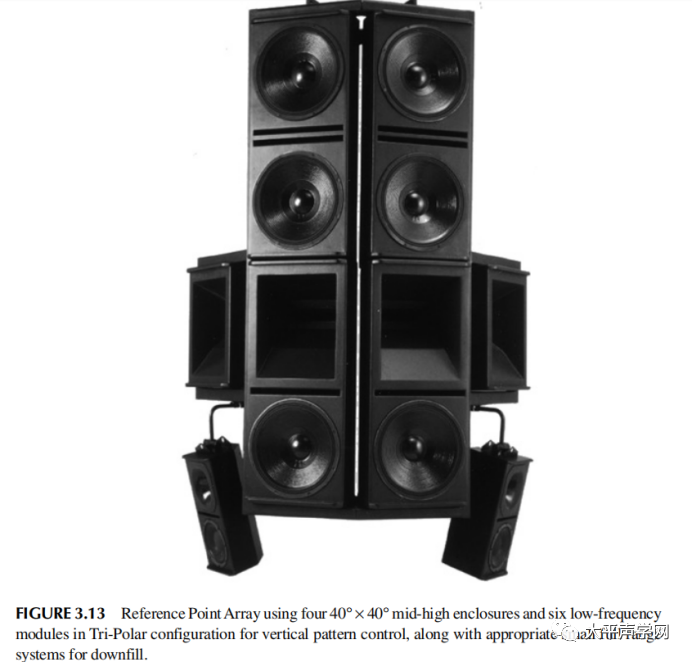1 垂直低音扬声器阵列(Vertical Woofer Array)
它是一种在垂直方向上排列多个低音扬声器单元的阵列。
2 水平低音扬声器阵列(Horizontal Woofer Array)
它是一种在水平方向上排列多个低音扬声器单元的阵列。
它是衡量扬声器喇叭(Horn)的尺寸大小的参数。通常通过其口径(直径)来表示,单位常用英寸(inch)或毫米(mm)。
(1)小尺寸喇叭:通常具有口径为几英寸的小型喇叭,适用于便携式音箱、汽车音响和低功率应用。它们可以提供良好的高频细节和定位精确度,但在低频方面可能受限。
(2)中等尺寸喇叭:这些喇叭通常具有口径在几英寸到十几英寸之间,并且适用于一般的家庭音响和商业应用。它们可以提供更全面的频率响应和较高的音量输出。
(3)大尺寸喇叭:大型喇叭通常具有更大的口径(超过十几英寸),在专业音响系统和大型场所中应用广泛。它们具有更高的功率处理能力、更低的低频延迟和更高的声压级。
3.6.2 Vertical Woofer Arrays
3.6.2.1 Directivity at Frequencies Where Size Makes Horns Impractical
喇叭Horns的大小对频率的指向性有一定影响(Horn的设计和参数还涉及到许多其他因素,例如角度、形状、材料等,这些因素也会对指向性产生影响)。
(1)在低频:大型喇叭对低频具有较好的指向性控制。它们可以在较低的频率范围内实现较为集中和定向的声场覆盖。它的振膜面积更大,能够产生更强的辐射和压力,从而实现更好的低频指向性;而小型喇叭在低频下的指向性控制相对较差。其辐射面积较小,无法产生足够的压力和辐射,导致低频声能更容易扩散,使得低频指向性较为宽松。
(2)高频:大型喇叭在高频下的指向性控制相对较差。由于高频波长较短,它的出口尺寸与波长比较接近,难以实现准确的指向性控制,容易出现较宽的扩散和辐射;而小型喇叭在高频下通常具有较好的指向性控制。其出口尺寸相对于波长来说较小,更容易实现较为准确的指向性,并将声能集中在狭窄的区域内。
以下是Vertical Woofer Array和Horizontal Woofer Array各自的优缺点,以及应用策略对比图(仅供参考)。
Beneficial destructive interference sounds like an oxymoron, but there are several commercially available woofer arrays that take advantage of this very technique. By applying the fundamental physics described by Harry Olson, directional woofer arrays are now available that outperform large woofer horns.
根据奥尔森的原理:当两个声音的点源相互组合或叠加时,它们的输出在所有方向上简单地相加。这意味着每个点源的声波相互叠加并共同向外传播,导致声音强度增加。
然而,随着两个点源之间距离的增加,会出现相位抵消的现象。在特定距离处,声波的峰值和谷值以一种干涉破坏性方式对齐。这导致声音强度降低,甚至在空间中的特定位置完全被抵消。在正好为半个波长(λ/2)的位置上,会产生纯零点或完全抵消。这一点非常关键,因为它构成了创建八字形或偶极子极性图案的基础。在这种极性图案中,声音强度集中在两个相反的方向上,而在两侧被抵消。
通过理解这一原理,扬声器设计师可以通过调整多个驱动器(如低音扬声器)的间距和排列方式来创建定向声音图案,并控制声能的传播。正如前面提到的垂直低音扬声器阵列,通过在垂直方向上间隔安排低音扬声器,利用这一原理实现偶极子指向图案。
Harry Olson is known for his contributions to the field of loudspeaker design and acoustics. One of his fundamental physics principles is related to interference and superposition of sound waves.
According to Olson's principle, when two point sources of sound are combined or superimposed on each other, their outputs simply add up in all directions. This means that the sound waves from each point source combine and propagate outward together, resulting in an increase in sound intensity.
However, as the distance between the two point sources increases, a phenomenon called phase cancellation occurs. At certain distances, the peaks and troughs of the sound waves align in such a way that they interfere destructively with each other. This results in a decrease in sound intensity or even complete cancellation at specific locations in space.
At exactly half a wavelength (λ/2), a pure null or cancellation occurs. This specific point is crucial because it forms the basis for creating directional sound patterns like the figure 8 or dipole polar pattern. In this polar pattern, the sound intensity is concentrated in two opposite directions while canceling out at the sides.
By understanding this principle, loudspeaker designers can manipulate the spacing and arrangement of multiple drivers (such as woofers) to create directional sound patterns and control the dispersion of sound energy. Vertical woofer arrays, as mentioned earlier, take advantage of this principle by spacing the woofers in a vertical configuration to achieve dipolar patterns.
Olson's work and understanding of interference and superposition have greatly influenced the design and development of loudspeakers, allowing for improved directivity and control over the sound field. His principles continue to be relevant in the field of acoustics and speaker system design today.
When two point sources are superimposed on one another, their outputs simply add up in all directions. As the two point sources are spread apart, the output diminishes along the plane of separation due to phase cancellation. At exactly ½ wavelength, a pure null occurs, and we achieve the classic figure 8, dipole polar pattern. The current commercially available systems take advantage of this phenomena, directivity through off-axis attenuation, by placing woofers in a vertical array and spacing them to create this dipolar pattern at frequencies below which horns become too large.

Tri-Polar设计包括两个侧面扬声器单元和一个中央扬声器单元。侧面扬声器单元位于主要听众位置的两侧,而中央扬声器位于主要听众位置正前方。每个扬声器单元都有自己的驱动器或阵列,以产生特定方向的声场。
它旨在提供更广泛的声场覆盖,并创造出一种环绕效果,使听众感受到来自多个方向的声音。通过将声音从两侧和中央投射出来,它可以提供更加沉浸式的音频体验,特别适合用于家庭影院系统或多媒体娱乐环境。
Figure 3.13 is an example of one such array. Termed Tri-Polar by its designer Vance Breshears, it uses the vertical spacing between the three woofers with appropriate signal processing to maintain consistent low-frequency pattern control from 400Hz down to below 100Hz. One of the first systems available was developed by Craig Janssen, termed Tuned Dipolar, which uses two separate arrays. With drivers, spacing, and signal processing appropriate for their respective passbands Tuned Dipolar offers exceptional low-frequency pattern control over an extended bandwidth. Even subwoofers are now benefitting from this type of technology. Meyer Sound is achieving cardioid patterns at lowest frequencies from its PSW‑6, providing significant attenuation of those frequencies directly behind the enclosures.
下图是Bi-Polar、Dipole和Termed Tri-Polar的各自优缺点和使用策略对比图(仅供参考):
扬声器布局类型
|
Bi-Polar
|
Dipole
|
Termed Tri-Polar
|
定义
|
扬声器配置包括两个相同的扬声器单元,这些单元背对背地放置在一个共享的箱体中。
|
扬声器配置包括两个背对背的扬声器单元,其振膜面向前方和后方辐射声音。
|
扬声器配置包括三个扬声器单元,两个侧面扬声器和一个中央扬声器。
|
优点
|
1扩散性好:Bi-Polar设计通过向前后两个方向辐射声音,可以提供更广泛的声场分布,创造出一种环绕感。
2立体感强:由于扬声器单元背对背放置,声音也会反射并与侧墙或后墙发生交互作用,增加了立体感和空间感。
|
1广泛的声场覆盖:Dipole设计创造出一种类似于开放空间的声学环境,能够产生更广泛、自然的声场分布。
2适合环绕声:由于不直接辐射到前方听众,Dipole扬声器常用于环绕声频道,提供沉浸式的环绕声音效。
|
1广泛的声场分布:通过将声音从两侧和中央投射出来,Tri-Polar设计可以提供更广泛的声场覆盖和沉浸式的音频体验。
2多方向指向性:Tri-Polar设计允许在前方和两侧产生不同的指向性模式,增加音频表现的灵活性。
|
缺点
|
相干性差:由于背对背放置的扬声器单元之间缺乏相位一致性,可能导致频率响应不均匀或出现干涉现象。
|
1低频响应受限:Dipole扬声器在低频范围内的输出会受到前后相位抵消的影响,导致低频响应有所下降。
2需要特殊的房间布局:由于Dipole扬声器的声场特性,对房间的反射和吸收要求较高,需要考虑房间的声学状况。
|
1空间需求较大:由于将三个扬声器单元放置在一起,Tri-Polar设计可能需要更大的空间来适应这种布局。
2需要精细调整:为了获得最佳性能,Tri-Polar扬声器系统需要进行仔细调整和校准,以确保每个扬声器单元之间的相位一致性和协调性。
|
使用策略
|
适用于家庭影院系统或多媒体娱乐环境,可以为听众提供沉浸式的环绕声音体验。然而,在良好的房间布局和调整中,需要注意解决相干性和均衡性的问题。
|
通常用于环绕声系统或多声道音响系统中,为听众提供真实感和沉浸感。它们适用于大型家庭影院、录音室等需要环绕声效果的场所。
|
用于家庭影院系统或多媒体娱乐环境中,特别适合那些希望实现全方位声音分布和沉浸式体验的用户。它们可以提供覆盖更广泛的听音区域,并允许通过调整各个扬声器单元来满足特定的声场需求。
|
【Reference】
《Electroacoustic Devices: Microphones and Loudspeakers》Edited by Glen Ballou
【免责声明】
推文引用的资料大部分来源于网络和书籍,推文的目的仅仅在于交流学习分享知识,并不意味着赞成和反对,且不为其版权负责。如涉及侵权,请及时联系我删除。
文章来源:大平声学网






















